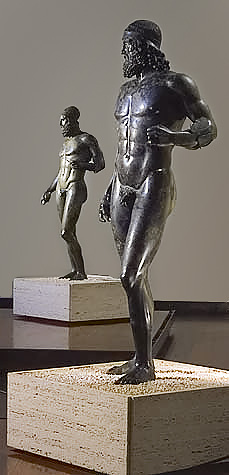Home › Forums › Ancient Civilizations › Advancement of the Greeks by the 5th century B.C.
- This topic has 2 voices and 1 reply.
-
AuthorPosts
-
September 9, 2011 at 1:15 pm #2929
 PhidippidesKeymaster
PhidippidesKeymasterWhat accounts for such great advancements by the Greeks? It is just amazing, really. Take, for example, a look at the plain old New York Kouros pictured below, and then the Riace Bronzes (sorry, I couldn't find a better photo) produced some 150 years later. Compare this with Egyptian statutes which for the most part remained relatively similar over the course of its 2000 years at the height of its power. With the Greeks, we have an awesome move into naturalism, where we actually see veins pulsating out of the flesh, we see feet modeled like real feet pressed down on the ground, and of course the implementation of contrapposto. One could say that the Greeks may have started out slowly with the New York Kouros and that they should have been more advanced at that time. Still, the Greeks were able to achieve a naturalism that the Egyptians never did, even though one could say that the Egyptians lived under more national security than the Greeks did. Anyway, it continues to impress me.
 WLA metmuseum Marble statue of a kouros youth 2 [CC-BY-2.5 (www.creativecommons.org/licenses/by/2.5)], by Wikipedia Loves Art participant "Futons_of_Rock", from Wikimedia CommonsNew York Kouros, c. 600 B.C.
WLA metmuseum Marble statue of a kouros youth 2 [CC-BY-2.5 (www.creativecommons.org/licenses/by/2.5)], by Wikipedia Loves Art participant "Futons_of_Rock", from Wikimedia CommonsNew York Kouros, c. 600 B.C. Reggio calabria museo nazionale bronzi di riace [Public domain], by Me (Me), from Wikimedia CommonsRiace Bronzes, c. 450 B.C.September 9, 2011 at 9:52 pm #25398
Reggio calabria museo nazionale bronzi di riace [Public domain], by Me (Me), from Wikimedia CommonsRiace Bronzes, c. 450 B.C.September 9, 2011 at 9:52 pm #25398 skiguyModerator
skiguyModeratorWhat accounts for such great advancements by the Greeks?
I honestly think it's because of colonization. They adopted and adapted other ideas and incorporated them in their own way. The Greek artists became free thinkers.I think this one from c. 570 B.C. is cool. It's simple, yet there's some good detailing in there. It's like a precursor to the Classical period.http://en.wikipedia.org/wiki/File:ACMA_Moschophoros.jpg
September 10, 2011 at 2:23 pm #25399 PhidippidesKeymaster
PhidippidesKeymasterI used to teach that one to my class, but haven't been able to the past few semesters because of time. Notice the Archaic “smile” on the statues – done to signify “life” in the figure. That type of grin would catch on in statues for at least a little while.
-
AuthorPosts
- You must be logged in to reply to this topic.




